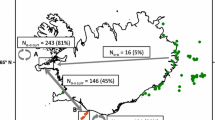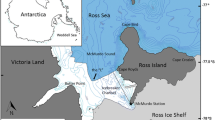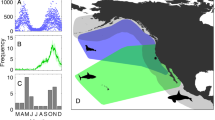Abstract
Individual heterogeneity in foraging behavior has been widely documented within predator populations. In highly social apex predators such as killer whales (Orcinus orca), specialization may occur at the matriline level. A small population of killer whales has been documented to occur around the Crozet Islands. These whales feed on a wide range of prey items including seals, penguins and large whales, as well as depredate the local Patagonian toothfish (Dissostichus eleginoides) longline fishery. The level of interactions with fisheries varies greatly between matrilines. Here, we present the results on the effects of such behavioral heterogeneity on the demographic trends of this killer whale population. We used photo-identification data from 1977 to 2011 in a mark–recapture framework to test the effect of varying levels of fisheries interactions on adult survival. We documented significant differences in survival between depredating and non-depredating whales, resulting in divergent intra-population demographic trends. These differences showed low survival, and thus a negative effect, for depredating whales when illegal fishing occurred (poachers used lethal methods to deter killer whales from depredating longlines). After illegal fishing stopped (2003–2011), the survival rates of depredating individuals exceeded the survival rates of non-depredating individuals, suggesting a positive influence of “artificial food provisioning”. This effect was further supported by a higher population growth rate for depredating whales. This study highlights the potential demographic costs and benefits that cetaceans face from depredating fisheries and addresses the demographic consequences of both intra-population feeding specialization and the influence of anthropogenic changes in resource availability.




Similar content being viewed by others
References
Begon M, Townsend CR, Harper JL (2006) Ecology: from individuals to ecosystems. Wiley-Blackwell, Oxford
Benton TG, Plaistow SJ, Coulson TN (2006) Complex population dynamics and complex causation: devils, details and demography. Proc R Soc Lond Ser B 273:1173–1181. doi:10.1098/rspb.2006.3495
Bigg MA, Olesiuk PF, Ellis GM, Ford JKB, Balcomb KC (1990) Social organization and genealogy of resident killer whales in the coastal waters of British Columbia and Washington State. Rep Int Whal Comm Spec Issue 12:383–405
Bolnick DI, Svanbäck R, Fordyce JA, Yang LH, Davis JM, Hulsey CD, Forister ML (2003) The ecology of individuals: incidence and implications of individual specialization. Am Nat 161:1–28. doi:10.1086/343878
Botsford LW, Castilla JC, Peterson CH (1997) The management of fisheries and marine ecosystems. Science 277:509–515. doi:10.1126/science.277.5325.509
Branch TA, Watson R, Fulton EA, Jennings S, McGilliard CR, Pablico GT, Ricard D, Tracey SR (2010) The trophic fingerprint of marine fisheries. Nature 468:431–435. doi:10.1038/nature09528
Brault S, Caswell H (1993) Pod-specific demography of killer whales (Orcinus orca). Ecology 74:1444–1454. doi:10.2307/1940073
Burnham KP, Anderson DR (2002) Model selection and multimodel inference: a practical information-theoretic approach. Springer, New York
Cairns DK (1987) Seabirds as indicators of marine food supplies. Biol Oceanogr 5:261–271
Carothers AD (1973) Capture-recapture methods applied to a population with known parameters. J Anim Ecol 42(1):125–146. doi:10.2307/3408
Choquet R, Lebreton JD, Gimenez O, Reboulet AM, Pradel R (2009a) U-CARE: utilities for performing goodness of fit tests and manipulating CApture–REcapture data. Ecography 32:1071–1074
Choquet R, Rouan L, Pradel R (2009b) Program E-SURGE: a software application for fitting multievent models. In: Thomson DL, Cooch EG, Conroy MJ (eds) Modeling demographic processes in marked populations. Environmental and ecological statistics. Springer, New York, pp 847–868
Clark CW, Yoshimura J (1993) Behavioral responses to variations in population size: a stochastic evolutionary game. Behav Ecol 4:282–288. doi:10.1093/beheco/4.3.282
Collins MA, Brickle P, Brown J, Belchier M (2010) The Patagonian toothfish: biology, ecology and fishery. Adv Mar Biol 58:227–300
Cormack RM (1964) Estimates of survival from the sighting of marked animals. Biometrika 51:429–438
Dahlheim ME, Waite JM (1993) Abundance and distribution of killer whales (Orcinus orca) in Alaska. Annual Report MMPA Assessment Program, Office of Protected Resources, NMFS, NOAA, Silver Spring
Dalla Rosa L, Secchi ER (2007) Killer whale (Orcinus orca) interactions with the tuna and swordfish longline fishery off southern and south-eastern Brazil: a comparison with shark interactions. J Mar Biol Assoc UK 87:135–140. doi:10.1017/S0025315407054306
Esteban R, Verborgh P, Gauffier P, Giménez J, Guinet C, De Stephanis R (2016a) Dynamics of killer whale, bluefin tuna and human fisheries in the Strait of Gibraltar. Biol Conserv 194:31–38
Esteban R, Verborgh P, Gauffier P, Giménez J, Foote AD, de Stephanis R (2016b) Maternal kinship and fisheries interaction influence killer whale social structure. Behav Ecol Sociobiol 70(1):111–122
Ford JKB, Ellis GM, Barrett-Lennard LG, Morton AB, Palm RS, Balcomb KC (1998) Dietary specialization in two sympatric populations of killer whales in coastal British Columbia and adjacent waters. Can J Zool 76(8):1456–1471. doi:10.1139/cjz-76-8-1456
Ford JKB, Ellis GM, Olesiuk PF, Balcomb KC (2009) Linking killer whale survival and prey abundance: food limitation in the oceans’ apex predator? Biol Lett 6:139–142. doi:10.1098/rsbl.2009.0468
Fuller TK, Sievert PR (2001) Carnivore demography and the consequences of changes in prey availability. In: Gittleman JL, Funk SM, Macdonald DW, Wayne RK (eds) Carnivore conservation. Cambridge University Press, Cambridge, pp 163–178
Gaillard J-M, Pontier D, Allainé D, Lebreton J-D, Trouvilliez J, Clobert J (1989) An analysis of demographic tactics in birds and mammals. Oikos 56:59–76. doi:10.2307/3566088
Gaillard J-M, Festa-Bianchet M, Yoccoz NG (1998) Population dynamics of large herbivores: variable recruitment with constant adult survival. Trends Ecol Evol 13:58–63. doi:10.1016/S0169-5347(97)01237-8
Ganas J, Robbins MM, Nkurunungi JB, Kaplin BA, McNeilage A (2004) Dietary variability of mountain gorillas in Bwindi Impenetrable National Park, Uganda. Int J Primatol 25:1043–1072. doi:10.1023/B:IJOP.0000043351.20129.44
Gimenez O, Lebreton J-D, Choquet R (2003) Parameter redundancy in multistate capture-recapture model. Biometrical J 45:704–722. doi:10.1002/bimj.200390043
Gowans S, Whitehead H (2001) Photographic identification of northern bottlenose whales (Hyperoodon ampullatus): sources of heterogeneity from natural marks. Mar Mamm Sci 17:76–93. doi:10.1111/j.1748-7692.2001.tb00981.x
Grosbois V, Gimenez O, Gaillard JM, Pradel R, Barbraud C, Clobert J, Møller AP, Weimerskirch H (2008) Assessing the impact of climate variation on survival in vertebrate populations. Biol Rev 83:357–399. doi:10.1111/j.1469-185X.2008.00047.x
Guinet C (1991) Intentional stranding apprenticeship and social play in killer whales (Orcinus orca). Can J Zool 69:2712–2716. doi:10.1139/z91-383
Guinet C (1992) Predation behavior of killer whales around Crozet Islands. Can J Zool 70:1656–1667
Guinet C, Jouventin P, Weimerskirch H (1999) Recent population change of the southern elephant seal at iles Crozet and Iles Kerguelen: the end of the decrease? Antarct Sci 11:193–197. doi:10.1017/S0954102099000255
Guinet C, Domenici P, de Stephanis R, Barrett-Lennard L, Ford JKB, Verborgh P (2007) Killer whale predation on bluefin tuna: exploring the hypothesis of the endurance-exhaustion technique. Mar Ecol Prog Ser 347:111–119. doi:10.3354/meps07035
Guinet C, Tixier P, Gasco N, Duhamel G (2015) Long-term studies of Crozet Island killer whales are fundamental to understanding the economic and demographic consequences of their depredation behaviour on the Patagonian toothfish fishery. ICES J Mar Sci 72(5):1587–1597
Hofbauer J, Sigmund K (1998) Evolutionary games and population dynamics. Cambridge University Press, Cambridge
Hucke-Gaete R, Moreno C, Arata J (2004) Operational interactions of sperm whales and killer whales with the Patagonian toothfish industrial fishery off southern Chile. Ccamlr Sci 11:127–140
Jolly GM (1965) Explicit estimates from capture-recapture data with both death and immigration-stochastic models. Biometrika 52:225–247
Kendall WL, Nichols JD, Hines JE (1997) Estimating temporary emigration using capture-recapture data with Pollock’s robust design. Ecology 78(2):563–578. doi:10.2307/2265960
Kokko H, Sutherland WJ (2001) Ecological traps in changing environments: ecological and evolutionary consequences of a behaviourally mediated Allee effect. Evol Ecol Res 3:537–551
Krebs JR, Davies NB (1993) An introduction to behavioural ecology. Blackwell, Cambridge
Kuningas S, Similä T, Hammond PS (2013) Population size, survival and reproductive rates of northern Norwegian killer whales (Orcinus orca) in 1986–2003. J Mar Biol Assoc UK 94(06):1277–1291. doi:10.1017/S0025315413000933
Lebreton JD, Pradel R (2002) Multistate recapture models: modelling incomplete individual histories. J Appl Stat 29(1–4):353–369. doi:10.1080/02664760120108638
Lebreton J-D, Burnham KP, Clobert J, Anderson DR (1992) Modelling survival and testing biological hypotheses using marked animals: a unified approach with case studies. Ecol Monogr 62:67–118. doi:10.2307/2937171
Leibold MA (1996) A graphical model of keystone predators in food webs: trophic regulation of abundance, incidence and diversity patterns in communities. Am Nat 147:784–812. doi:10.1086/285879
Lewison RL, Crowder LB, Read AJ, Freeman SA (2004) Understanding impacts of fisheries bycatch on marine megafauna. Trends Ecol Evol 19:598–604. doi:10.1016/j.tree.2004.09.004
Marcoux M, Whitehead H, Rendell L (2007) Sperm whale feeding variation by location, year, social group and clan: evidence from stable isotopes. Mar Ecol Prog Ser 333:309–314. doi:10.3354/meps333309
Matkin CO (1986) Killer whale interactions with the sablefish longline fishery in Prince William Sound, Alaska, 1985, with comments on the Bering Sea. Contract No. 010686. NMFS, NMML, Juneau, Alaska. 10
Matkin CO, Matkin DR, Ellis GM, Saulitis E, McSweeney D (1997) Movements of resident killer whales in southeastern Alaska and Prince William Sound, Alaska. Mar Mamm Sci 13:469–475. doi:10.1111/j.1748-7692.1997.tb00653.x
Matkin CO, Barrett-Lennard LG, Yurk H, Ellifrit D, Trites AW (2007) Ecotypic variation and predatory behavior among killer whales (Orcinus orca) off the eastern Aleutian Islands, Alaska. Fish Bull 105:74–87
Morris WF, Doak DF (2002) Quantitative conservation biology: theory and practice of population viability analysis. Sinauer Associates, Sunderland
Myers RA, Worm B (2003) Rapid worldwide depletion of predatory fish communities. Nature 423:280–283. doi:10.1038/nature01610
Nelson LJ, Anderson DR, Burnham KP (1980) The effect of band loss on estimates of annual survival. J Field Ornithol 51(1):30–38
Nichols JD (1992) Capture-recapture models. Bioscience 42(2):94–102
Nichols JD, Stokes SL, Hines JE, Conroy MJ (1982) Additional comments on the assumption of homogeneous survival rates in modern bird banding estimation models. J Wildl Manag 46(4):953–962. doi:10.2307/3808228
Northridge SP (1991) An updated world review of interactions between marine mammals and fisheries. FAO Fisheries Technical Paper 251, Supplement 1. http://www.fao.org/docrep/003/T0452E/T0452E00.HTM. Accessed January 30 2017
Northridge SP, Hoffman RJ (1999) Marine mammal interactions with fisheries. In: Twiss JR, Reeves RR (eds) Conservation and management of marine mammals. Smithsonian Institution Press, Washington, pp 99–119
O’Donoghue M, Boutin S, Krebs CJ, Hofer EJ (1997) Numerical responses of coyotes and lynx to the snowshoe hare cycle. Oikos 80:150–162. doi:10.2307/3546526
Olesiuk P, Bigg M, Ellis G (1990) Life history and population dynamics of resident killer whales (Orcinus orca) in the coastal waters of British Columbia and Washington State. Rep Int Whal Comm 12:209–242
Olesiuk PF, Ellis GM, Ford JKB (2005) Life history and population dynamics of northern resident killer whales in British Columbia. Research document 2005/45, Ottawa, Canada: Canadian Science Advisory Secretariat, Fisheries and Oceans Canada. http://www.dfo-po.gc.ca/csas/Csas/Publications/ResDocs-DocRech/2005/2005_045_e.htm. Accessed January 30 2017
Parsons KM, Balcomb KC, Ford JKB, Durban JW (2009) The social dynamics of southern resident killer whales and conservation implications for this endangered population. Anim Behav 77(4):963–971. doi:10.1016/j.anbehav.2009.01.018
Pollock KH, Raveling DG (1982) Assumptions of modern band-recovery models, with emphasis on heterogeneous survival rates. J Widl Manag 46(1):88–98. doi:10.2307/3808411
Poncelet E, Barbraud C, Guinet C (2010) Population dynamics of killer whales in Crozet Archipelago, southern Indian Ocean: a mark recapture study from 1977 to 2002. J Cetacean Res Manag 11(1):41–48
Pradel R (1993) Flexibility in survival analysis from recapture data: handling trap dependence. In: Lebreton J-D, North PM (eds) Marked individuals in the study of bird population. Birkhäuser Velag, Basel, pp 29–37
Pruvost P, Duhamel G, Gasco N, Palomares MD (2015) A short history of the fisheries of Crozet islands. FCRR 23(1):31–37
Purves MG, Agnew DJ, Balguerias E, Moreno CA, Watkins B (2004) Killer whale (Orcinus orca) and sperm whale (Physeter macrocephalus) interactions with longline vessels in the Patagonian toothfish fishery at South Georgia, South Atlantic. Ccamlr Sci 11:111–126
R Development Core Team (2013) R: a language and environment for statistical computing. R Foundation for Statistical Computing, Vienna
Rausher MD (1984) Tradeoffs in performance on different hosts-evidence from within site and between site variation in the beetle Deloyala guttata. Evolution 38:582–595. doi:10.2307/2408708
Reisinger RR, Gröcke DR, Lübcker N, McClymont EL, Hoelzel AR, de Bruyn PN (2016) Variation in the diet of killer whales Orcinus orca at Marion Island, Southern Ocean. Mar Ecol Prog Ser 549:263–274
Rendell L, Whitehead H (2001) Culture in whales and dolphins. Behav Brain Sci 24:309. doi:10.1017/S0140525X0100396X
Roche C, Guinet C, Gasco N, Duhamel G (2007) Marine mammals and demersal longlines fishery interactions in Crozet and Kerguelen exclusive economic zones: an assessment of the depredation level. CCAMLR Sci 14:67–82
Schakner ZA, Lunsford C, Straley J, Eguchi T, Mesnick SL (2014) Using models of social transmission to examine the spread of longline depredation behavior among sperm whales in the Gulf of Alaska. PLoS One 9:109079. doi:10.1371/journal.pone.0109079
Seber GAF (1965) A note on the multiple recapture census. Biometrika 52:249–259
Smout S, Rindorf A, Hammond PS, Harwood J, Matthiopoulos J (2013) Modelling prey consumption and switching by UK grey seals. ICES J Mar Sci 71:81–89. doi:10.1093/icesjms/fst109
Stubben CJ, Milligan BG (2007) Estimating and analyzing demographic models using popbio package in R. J Stat Softw 22:11
Tixier P (2012) Déprédation par les orques (Orcinus Orca) et les cachalots (Physeter Macrocephalus) sur les palangriers à la legine australe dans la ZEE de l’archipel de Crozet. Dissertation, University of Aix-Marseille II
Tixier P, Gasco N, Duhamel G, Guinet C (2010) Interactions of Patagonian toothfish fisheries with killer and sperm whales: an assessment of depredation levels and insights on possible mitigation solutions. CCAMLR Sci 17:179–195
Tixier P, Gasco N, Guinet C (2014) Killer whales of the Crozet islands, photo-identification catalogue 2003–2011. Villiers en Bois: Centre d’Etudes Biologiques de Chizé-CNRS. doi:10.6084/m9.figshare.1085960 (accessed January 30 2017)
Tixier P, Authier M, Gasco N, Guinet C (2015) Influence of artificial food provisioning from fisheries on killer whales reproductive output. Anim Conserv 18(2):207–208. doi:10.1111/acv.12161
Tremblay-Boyer L, Gascuel D, Watson R (2011) Modelling the effects of fishing on the biomass of the world’s oceans from 1950 to 2006. Mar Ecol Prog Ser 442:169–185
Trites AW, Christensen V, Pauly D (1997) Competition between fisheries and marine mammals for prey and primary production in the Pacific Ocean. J Northwest Atl Fish Soc 22:173–187
Tuck GN, Polacheck T, Croxall JP, Weimerskirch H (2001) Modelling the impact of fishery by-catches on albatross populations. J Appl Ecol 38:1182–1196. doi:10.1046/j.0021-8901.2001.00661.x
Turchin P (2003) Complex population dynamics: a theoretical/empirical synthesis. Princeton University Press, Princeton
Ward EJ, Holmes EE, Balcomb KC (2009) Quantifying the effects of prey abundance on killer whale reproduction. J Appl Ecol 46:632–640. doi:10.1111/j.1365-2664.2009.01647.x
Wauters L, Swinnen C, Dhondt AA (1992) Activity budget and foraging behavior of red squirrels in coniferous and deciduous habitats. J Zool 227:71–86
Werner EE, Gilliam JF (1984) The ontogenetic niche and species interactions in size-structured populations. Annu Rev Ecol Syst 15:393–425. doi:10.1146/annurev.ecolsys.15.1.393
White GC, Burnham KP (1999) Program MARK: survival estimation from populations of marked animals. Bird Study 46:120–138
Whitehead H, Rendell L, Osborne RW, Würsig B (2004) Culture and conservation of non-humans with reference to whales and dolphins: review and new directions. Biol Conserv 120(3):427–437. doi:10.1016/j.biocon.2004.03.017
Whiten A (2000) Primate culture and social learning. Cognit Sci 24:477–508. doi:10.1016/S0364-0213(00)00027-6
Williams R, Lusseau D (2006) A killer whale social network is vulnerable to targeted removals. Biol Lett 2:497–500. doi:10.1098/rsbl.2006.0510
Williams BK, Nichols JD, Conroy MJ (2002) Analysis and management of animal populations. Academic Press, San Diego
Yano K, Dahlheim ME (1995a) Killer whale, Orcinus orca, depredation on longline catches of bottom fish in the southeastern Bering Sea and adjacent waters. Fish Bull 93:355–372
Yano K, Dahlheim ME (1995b) Behavior of killer whales Orcinus orca during longline fishery interactions in the southeastern Bering Sea and adjacent waters. Fish Sci 61:584–589
Acknowledgements
This work was conducted as part of the 109 program (Resp. H. Weimerskirch) with the Institut Polaire Français (IPEV). Funding and logistic support was provided by the Terres Australes et Antarctiques Françaises (TAAF), the Réserve Naturelle des Terres Australes and the Reunion Island Fisheries Companies. We are grateful to the Muséum National d’Histoire Naturelle, Paris and especially P. Pruvost, A. Martin and C. Chazeau, for providing data from the “PECHEKER” database. Special thanks to all the photographers and fish observers who helped collect photo-identification images. We are extremely grateful to Dr. Holly Fearnbach for proofreading the manuscript and for her insightful comments. We thank N. G. Yoccoz and O. Gimenez for constructive comments on the methods used in the study. We also thank the reviewers for their insightful comments. The first author was financially supported by the French fishing association (SARPC), the TAAF administration (contract number 782095), and the Secrétariat d’état chargé de l’Outre Mer (contract number 782135).
Author information
Authors and Affiliations
Corresponding author
Ethics declarations
Funding
The first author was financially supported by the French fishing association (SARPC), the TAAF administration (contract number 782095), and the Secrétariat d’état chargé de l’Outre Mer (contract number 782135).
Conflict of interest
The authors declare that they have no conflict of interest.
Ethical approval
This article does not contain any studies with animals performed by any of the authors.
Informed consent
Informed consent was obtained from all individual participants included in the study.
Additional information
Responsible Editor: U. Siebert.
Reviewed by R. Esteban and an undisclosed expert.
Electronic supplementary material
Below is the link to the electronic supplementary material.
Rights and permissions
About this article
Cite this article
Tixier, P., Barbraud, C., Pardo, D. et al. Demographic consequences of fisheries interaction within a killer whale (Orcinus orca) population. Mar Biol 164, 170 (2017). https://doi.org/10.1007/s00227-017-3195-9
Received:
Accepted:
Published:
DOI: https://doi.org/10.1007/s00227-017-3195-9




